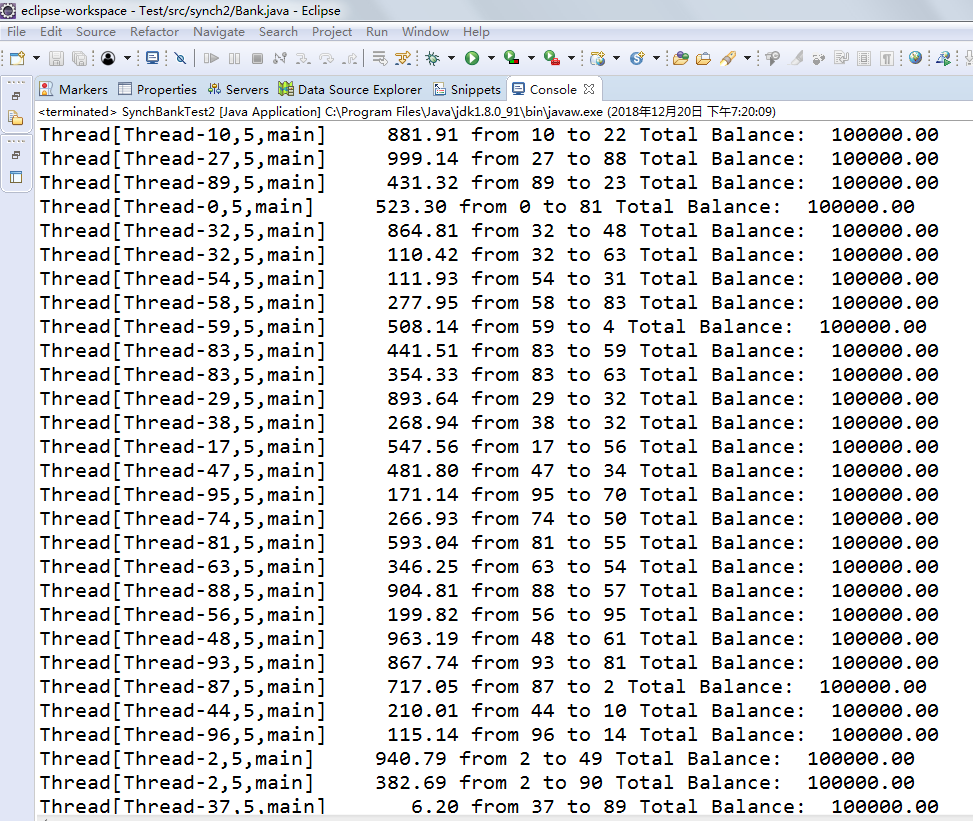狄慧201771010104《面向物件程式設計(java)》第十七週學習總結
一.理論知識部分
Java 的執行緒排程採用優先順序策略:優先順序高的先執行,優先順序低的後執行;多執行緒系統會自動為每個執行緒分配一個優先順序,預設時,繼承其父類的優先順序; 任務緊急的執行緒,其優先順序較高; 同優先順序的執行緒按“先進先出”的佇列原則。
呼叫setPriority(int a)重置當前執行緒的優先順序,a取值可以是前述的三個靜態量。呼叫getPriority()獲得當前執行緒優先順序。
多執行緒併發執行不確定性問題解決方案:引入執行緒同步機制,使得另一執行緒要使用該方法,就只能等待。
在Java中解決多執行緒同步問題的方法有兩種:J ava SE 5.0中引入ReentrantLock類。 在共享記憶體的類方法前加synchronized修飾符。
有關鎖物件和條件物件的關鍵要點:鎖用來保護程式碼片段,保證任何時刻只能有一個執行緒執行被保護的程式碼。鎖管理試圖進入被保護程式碼段的執行緒。鎖可擁有一個或多個相關條件物件。每個條件物件管理那些已經進入被保護的程式碼 段但還不能執行的執行緒。
synchronized關鍵字作用: 某個類內方法用synchronized 修飾後,該方法被稱為同步方法;只要某個執行緒正在訪問同步方法,其他執行緒欲要訪問同步方法就被阻塞,直至執行緒從同 步方法返回前喚醒被阻塞執行緒,其他執行緒方可能進入同步方法。
在同步方法中使用wait()、notify 和notifyAll()方法:一個執行緒在使用的同步方法中時,可能根據問題的需要,必須使用wait()方法使本執行緒等待,暫時讓出CPU的使用權,並允許其它執行緒使用這個同步方法。執行緒如果用完同步方法,應當執行notifyAll()方 法通知所有由於使用這個同步方法而處於等待的執行緒結束等待。
二.實驗部分
1、實驗目的與要求
(1) 掌握執行緒同步的概念及實現技術;
(2) 執行緒綜合程式設計練習
2、實驗內容和步驟
實驗1:測試程式並進行程式碼註釋。
測試程式1:
l 在Elipse環境下除錯教材651頁程式14-7,結合程式執行結果理解程式;
l 掌握利用鎖物件和條件物件實現的多執行緒同步技術。
package synch; /** * This program shows how multiple threads can safely access a data structure. * @version 1.31 2015-06-21 * @author Cay Horstmann*/ public class SynchBankTest { public static final int NACCOUNTS = 100; public static final double INITIAL_BALANCE = 1000; public static final double MAX_AMOUNT = 1000; public static final int DELAY = 10; public static void main(String[] args) { Bank bank = new Bank(NACCOUNTS, INITIAL_BALANCE); for (int i = 0; i < NACCOUNTS; i++) { int fromAccount = i; Runnable r = () -> { try { while (true) { int toAccount = (int) (bank.size() * Math.random()); double amount = MAX_AMOUNT * Math.random(); bank.transfer(fromAccount, toAccount, amount); Thread.sleep((int) (DELAY * Math.random()));//隨機生成時間,使正在執行的執行緒休眠 } } catch (InterruptedException e) { } }; Thread t = new Thread(r); t.start();//開始執行緒 } } } SynchBankTest
package synch; import java.util.*; import java.util.concurrent.locks.*; /** * A bank with a number of bank accounts that uses locks for serializing access. * @version 1.30 2004-08-01 * @author Cay Horstmann */ public class Bank { private final double[] accounts; private Lock bankLock; private Condition sufficientFunds; /** * Constructs the bank. * @param n the number of accounts * @param initialBalance the initial balance for each account */ public Bank(int n, double initialBalance) { accounts = new double[n]; Arrays.fill(accounts, initialBalance); bankLock = new ReentrantLock(); sufficientFunds = bankLock.newCondition(); } /** * Transfers money from one account to another. * @param from the account to transfer from * @param to the account to transfer to * @param amount the amount to transfer */ public void transfer(int from, int to, double amount) throws InterruptedException { bankLock.lock();//使用鎖物件,獲取鎖 try { while (accounts[from] < amount) sufficientFunds.await(); System.out.print(Thread.currentThread()); accounts[from] -= amount; System.out.printf(" %10.2f from %d to %d", amount, from, to); accounts[to] += amount; System.out.printf(" Total Balance: %10.2f%n", getTotalBalance()); sufficientFunds.signalAll();//喚醒所有執行緒 } finally { bankLock.unlock();//釋放鎖 } } /** * Gets the sum of all account balances. * @return the total balance */ public double getTotalBalance() { bankLock.lock(); try { double sum = 0; for (double a : accounts) sum += a; return sum; } finally { bankLock.unlock(); } } /** * Gets the number of accounts in the bank. * @return the number of accounts */ public int size() { return accounts.length; } } Bank

測試程式2:
l 在Elipse環境下除錯教材655頁程式14-8,結合程式執行結果理解程式;
l 掌握synchronized在多執行緒同步中的應用。
package synch2; import java.util.*; /** * A bank with a number of bank accounts that uses synchronization primitives. * @version 1.30 2004-08-01 * @author Cay Horstmann */ public class Bank { private final double[] accounts; /** * Constructs the bank. * @param n the number of accounts * @param initialBalance the initial balance for each account */ public Bank(int n, double initialBalance) { accounts = new double[n]; Arrays.fill(accounts, initialBalance); } /** * Transfers money from one account to another. * @param from the account to transfer from * @param to the account to transfer to * @param amount the amount to transfer */ //使用synchronized修飾符 public synchronized void transfer(int from, int to, double amount) throws InterruptedException { while (accounts[from] < amount) wait();//來自Object類 System.out.print(Thread.currentThread()); accounts[from] -= amount; System.out.printf(" %10.2f from %d to %d", amount, from, to); accounts[to] += amount; System.out.printf(" Total Balance: %10.2f%n", getTotalBalance()); notifyAll();//解除所有執行緒的阻塞狀態 } /** * Gets the sum of all account balances. * @return the total balance */ public synchronized double getTotalBalance() { double sum = 0; for (double a : accounts) sum += a; return sum; } /** * Gets the number of accounts in the bank. * @return the number of accounts */ public int size() { return accounts.length; } } Bank
package synch2; /** * This program shows how multiple threads can safely access a data structure, * using synchronized methods. * @version 1.31 2015-06-21 * @author Cay Horstmann */ public class SynchBankTest2 { public static final int NACCOUNTS = 100; public static final double INITIAL_BALANCE = 1000; public static final double MAX_AMOUNT = 1000; public static final int DELAY = 10; public static void main(String[] args) { Bank bank = new Bank(NACCOUNTS, INITIAL_BALANCE); for (int i = 0; i < NACCOUNTS; i++) { int fromAccount = i; Runnable r = () -> { try { while (true) { int toAccount = (int) (bank.size() * Math.random()); double amount = MAX_AMOUNT * Math.random(); bank.transfer(fromAccount, toAccount, amount); Thread.sleep((int) (DELAY * Math.random())); } } catch (InterruptedException e) { } }; Thread t = new Thread(r); t.start(); } } } SynchBankTest2

測試程式3:
l 在Elipse環境下執行以下程式,結合程式執行結果分析程式存在問題;
l 嘗試解決程式中存在問題。
| class Cbank { private static int s=2000; public static void sub(int m) { int temp=s; temp=temp-m; try { Thread.sleep((int)(1000*Math.random())); } catch (InterruptedException e) { } s=temp; System.out.println("s="+s); } }
class Customer extends Thread { public void run() { for( int i=1; i<=4; i++) Cbank.sub(100); } } public class Thread3 { public static void main(String args[]) { Customer customer1 = new Customer(); Customer customer2 = new Customer(); customer1.start(); customer2.start(); } } |
class Cbank { private static int s=2000; public static synchronized void sub(int m) { int temp=s; temp=temp-m; try { Thread.sleep((int)(1000*Math.random())); } catch (InterruptedException e) { } s=temp; System.out.println("s="+s); } } class Customer extends Thread { public void run() { for( int i=1; i<=4; i++) Cbank.sub(100); } } public class Thread3 { public static void main(String args[]) { Customer customer1 = new Customer(); Customer customer2 = new Customer(); customer1.start(); customer2.start(); } } Cbank

實驗2 程式設計練習
利用多執行緒及同步方法,編寫一個程式模擬火車票售票系統,共3個視窗,賣10張票,程式輸出結果類似(程式輸出不唯一,可以是其他類似結果)。
Thread-0視窗售:第1張票
Thread-0視窗售:第2張票
Thread-1視窗售:第3張票
Thread-2視窗售:第4張票
Thread-2視窗售:第5張票
Thread-1視窗售:第6張票
Thread-0視窗售:第7張票
Thread-2視窗售:第8張票
Thread-1視窗售:第9張票
Thread-0視窗售:第10張票
public class Demo { public static void main(String[] args) { Myrhread myrhread = new Myrhread(); Thread t1 = new Thread(myrhread); Thread t2 = new Thread(myrhread); Thread t3 = new Thread(myrhread); t1.start(); t2.start(); t3.start(); } } class Myrhread implements Runnable { int t = 1; boolean flag = true; public void run() { while (flag) { try { Thread.sleep(500); } catch (InterruptedException e) { e.printStackTrace(); } synchronized (this) { if (t <= 10) { System.out.println(Thread.currentThread().getName() + "視窗售:第" + t + "張票"); t++; } if (t > 10) { flag = false; } } } } } Demo

三、實驗總結:
本週的實驗容量很少,實驗也相對來說簡單,完成的還算順利。學長也教了我們常用的一些快捷鍵,本週的收穫還是很大的。在以後的學習中我會繼續完善在這門語言學習中我的不足,也會銘記老師的教誨,不會學完之後就忘記,而是學會使用這門語言解決以後學習中的問題。在這裡對老師和學長再次表示真摯的感謝。
